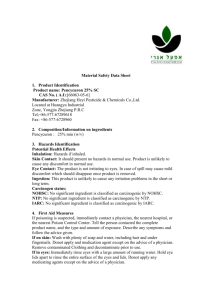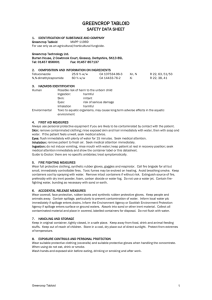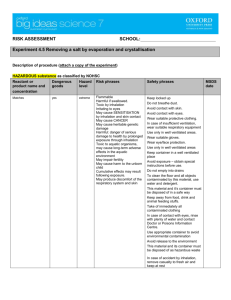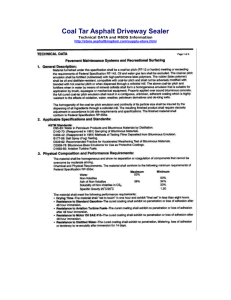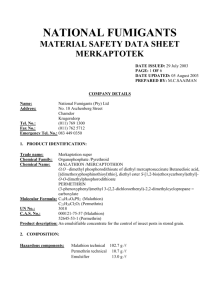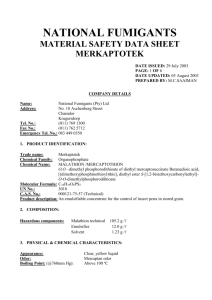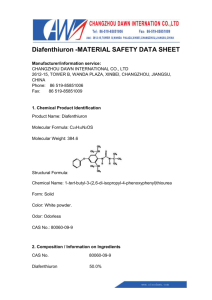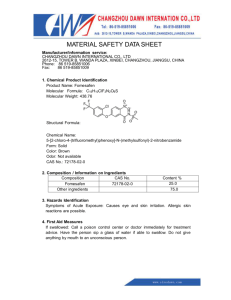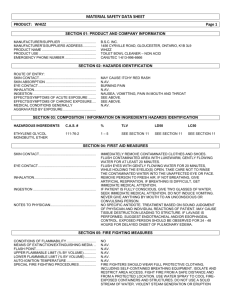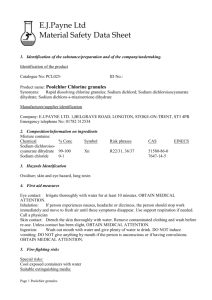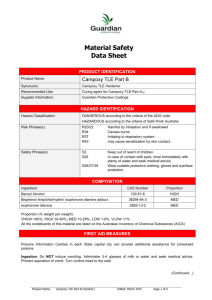respiratory landfill
advertisement
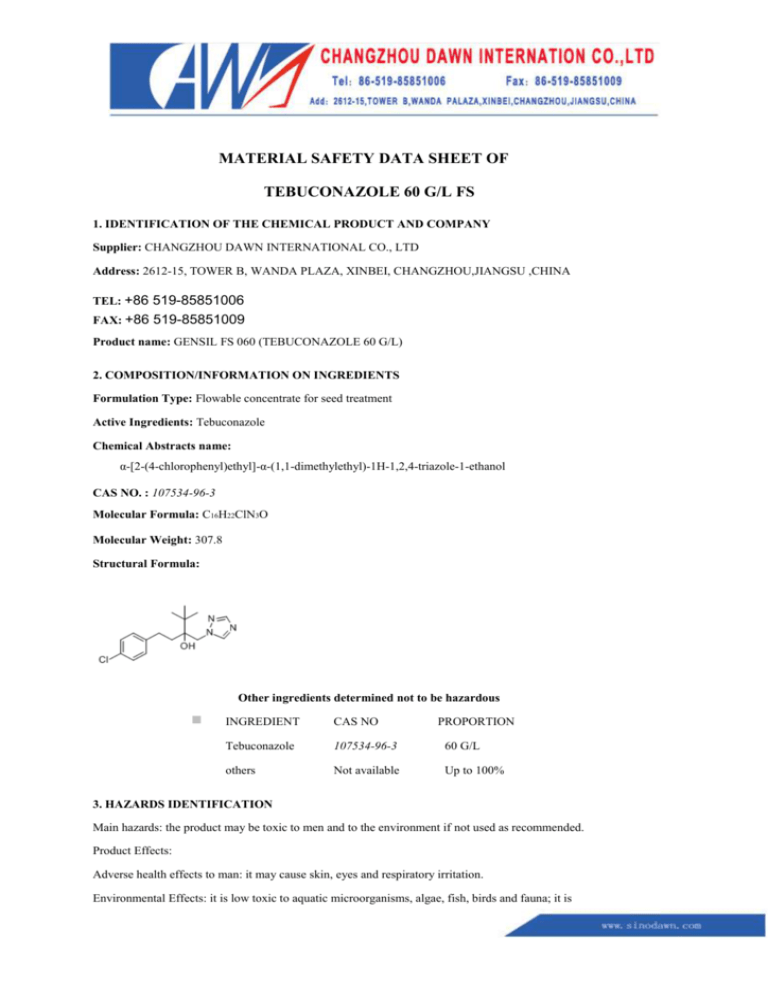
MATERIAL SAFETY DATA SHEET OF TEBUCONAZOLE 60 G/L FS 1. IDENTIFICATION OF THE CHEMICAL PRODUCT AND COMPANY Supplier: CHANGZHOU DAWN INTERNATIONAL CO., LTD Address: 2612-15, TOWER B, WANDA PLAZA, XINBEI, CHANGZHOU,JIANGSU ,CHINA TEL: +86 519-85851006 FAX: +86 519-85851009 Product name: GENSIL FS 060 (TEBUCONAZOLE 60 G/L) 2. COMPOSITION/INFORMATION ON INGREDIENTS Formulation Type: Flowable concentrate for seed treatment Active Ingredients: Tebuconazole Chemical Abstracts name: α-[2-(4-chlorophenyl)ethyl]-α-(1,1-dimethylethyl)-1H-1,2,4-triazole-1-ethanol CAS NO. : 107534-96-3 Molecular Formula: C16H22ClN3O Molecular Weight: 307.8 Structural Formula: . Other ingredients determined not to be hazardous INGREDIENT CAS NO PROPORTION Tebuconazole 107534-96-3 60 G/L others Not available Up to 100% 3. HAZARDS IDENTIFICATION Main hazards: the product may be toxic to men and to the environment if not used as recommended. Product Effects: Adverse health effects to man: it may cause skin, eyes and respiratory irritation. Environmental Effects: it is low toxic to aquatic microorganisms, algae, fish, birds and fauna; it is considered non toxic to bees. Specific hazards: there are no other hazards related to the product. Main Symptoms: high concentration inhalation may cause nasal, throat and respiratory tracts irritation. The ingestion of large amounts may cause abdominal discomfort or pain, nausea, vomiting, dizziness and blurred vision. 4. FIRST AID MEASURES General Information: You should call The Poisons Information Centre if you feel that you may have been poisoned, burned or irritated by this product. Have this MSDS with you when you call. First Aid Measures: Remove to fresh air. Remove all contaminated clothing and wash the affected parts of the body thoroughly with plenty of water during 30 minutes. If victim is unconscious and not breathing, apply artificial respiration or oxygenation. Take victim to the nearest medical care center. Inhalation: remove to fresh air. If stops breathing, apply artificial respiration. If breathing is difficult, immediately call a physician. Skin contact: immediately wash with plenty of water during 30 minutes after removing contaminated clothing. In case of effects/symptoms, call a physician. Wash the contaminated clothing prior to reuse them and dispose contaminated shoes. Eye contact: immediately flush with running water for at least 30 minutes. Call a physician. Ingestion: do not induce vomiting, but do not stop if it happens spontaneously. Immediately call a physician. Actions to be avoided: do not apply mouth to mouth respiration if the patient has swollen the product. Give artificial respiration. Protection for the first aid givers: avoid skin or inhalation contact with the product during the process. Notes for the physician: no specific antidote is available. Symptomatic treatment must include, specially, support measures as the correction of hydro electrolytic and metabolic disorders, as well as respiratory aid. The management of hepatic and renal functions must be kept. If in eye, rinse with physiological saline followed by occlusion and lead to ophthalmic evaluation. 5. FIRE FIGHTING MEASURES Extinguishing media: Foam, CO2, dry chemical and, in last case, water spray. Special Procedures: wear appropriate PPE (personal protective equipment) to avoid direct contact with the product. PVC overall, rubber gloves and rubber boots are recommended. Wear self-contained breathing apparatus. 6. ACCIDENT RELEASE MEASURES Personal precautions: wear waterproof overalls, safety goggles, rubber boots and nitril rubber, latex or PVC gloves. Respiratory protection must be used depending on the concentrations in the environment or on the extension of the spill/release. In this case, choose self-contained breathing apparatus. Removal of ignition sources: stop electric energy and turn off the sources that may produce sparks. Remove all the material that may start a fire (e.g. spilled diesel oil). Dust control: isolate and signal the contaminated area. Cover the spill with plastic sheet or spray water on the powder. Use water only under supervision of specialized personnel. Inhalation, skin, mucous membrane and eyes contact prevention: wear the garments and accessories described above. Environmental precautions: avoid contamination of surface waters sealing the entrance of the rain water galleries (culverts). Do not allow the residues of the released product reach water collections. Cleaning methods: stop and collect the spill. As the product is solid, collect, preferably without other substances as sawdust or other product, so avoiding the volume increase of collected contaminated material, which facilitates its recovering. Put the residues into an appropriate recipient for disposal according to the local regulations. Clean, preferably with a detergent; avoid using solvents. Secondary hazards prevention: do not allow the product contaminate creeks, lakes, water fountains, wells, sewers, pluvial sewers and effluents. 7. HANDLING AND STORAGE Handling: Keep people, and specially children and domestic animals away from the place of work. Do not have direct contact with the product. Avoid leak or contamination of the application equipment during its supply. Users should wear PPE as described on item 8. Do not eat, drink or smoke during product handling. When opening a packaging, do it in a way to avoid leak. Storage: Keep the product in its original containers. Keep eventual residues of the product in its original packaging, appropriately closed. Keep the container appropriately closed, at room temperature and protected from light. Keep it in a duly identified, exclusive place for toxic products. Lock the place to avoid the access of unauthorized persons and children. Avoid humid places and places with sources of heat. 8. EXPOSURE CONTROLS/PERSONAL PROTECTION Engineering controls: whenever applicable use ventilators, air circulators, exhausters suitable for gases and vapors; provide the work area with appropriate ventilation. The operator must always use breathing protective equipment, even when there is a good natural or mechanical ventilation. Recommended monitoring procedure: Perform tests of hepatic and urinary functions, product detection in collected vomiting or washed skin. Check the product residue dosage in the blood. Personal protective equipment: Hands protection: wear nitril rubber, latex, PVC or other waterproof and tear/perforation resistant material gloves. Eye protection: wear safety goggles for chemical products. Skin and body protection: wear long sleeve waterproof or hydro-repellent overalls and PVC boots. Special Precautions: keep PPE duly clean and in adequate use conditions, performing inspections, sanitization and possible maintenance and/or substitution of damaged/defective equipment and parts from time to time. Hygiene measures: take shower and change the clothing after using the product. Wash contaminated clothing separately, avoiding its contact with another personal use tools. 9. PHYSICAL AND CHEMICAL PROPERTIES Form: Red flowable thick liquid Odour: characteristic Density: Approx. 1.03 g/ml pH: not determined Boiling Point : NA Melting point: NA Flashpoint: not flammable Explosivity: not explosive Solubility: dispersive in water 10. STABILITY AND REACTIVITY Chemical stability: the product is stable under normal temperature and storage conditions. Hazardous reactions: there is no hazardous reaction known. Hazardous decomposition products: fire produces carbon monoxide, carbon dioxide, nitrous oxide, chlorides and other non-identifiable organic substances. 11. TOXICOLOGICAL IMFORMATION Acute toxicity: Oral LD50 rat: > 2000 mg/kg Dermal LD50 rat: >2000 mg/kg Inhalation toxicity LC50 rat: 2.04mg/L Irritant properties: Skin irritation: Not irritating (rabbit) Eye irritation: Not irritating (rabbit) Allergenic and sensitizing effects: the product is considered non sensitizing Mutagenicity: the product is considered non-mutagenic. Carcinogenicity: the active ingredient is considered non-carcinogenic. Teratogenicity: the active ingredient is considered non-teratogenic. Reproductive effects: the active ingredient is considered as having no reproductive effect. 12. ECOLOGICAL IMFORMATION The following information is for the active ingredient, Tebuconazole. Ecotoxicity: Birds Acute oral LD50: for bobwhite quail 1988 mg/kg b.w. Dietary LC50 (5 days): for mallard ducks >4816, bobwhite quail >5000 mg/kg feed. Fish LC50 (96 h): for rainbow trout 4.4, bluegill sunfish 5.7 mg/l (flow through). Daphnia EC50: (48 h) 4.2 mg/l (flow through). Algae EC50: (72 h, static) for Selenastrum capricornutum 3.80 mg/l. Bees LD50 (oral): 83 μg/bee. LD50 (contact): >200 μg/bee. Earthworm: LC50 (14 days): for Eisenia foetida 1381 mg/kg dry soil. 13. DISPOSAL CONSIDERATION Product: Whenever possible, product should be used for its intended purpose, even if reclaimed from spillage (reclaimed product must be uncontaminated). Containers: Whenever possible, follow directions given on container. If not available, triple or pressure rinse plastic or metal containers before disposal. Recycle containers if possible (replace cap and return clean containers to recycler or designated collection point). Treat rinsings as for product above. If not recycling, break, crush or puncture and bury empty containers in a local authority landfill. If no landfill is available, bury the containers below 500 mm in a disposal pit specifically marked and set up for this purpose clear of waterways, desirable vegetation and tree roots. Empty containers and product should not be burnt. Sewage: Do not dispose of product or rinsings into sewage systems or septic tanks. 14. TRANSPORT INFORMATION Not available. 15. REGULATARY INFORMATION Risk symbols: Not Dangerous to the environment 16. OTHER INFORMATION This MSDS summarizes our best knowledge of the health and safety hazard information of the product and how to safely handle and use the product in the workplace. Each user should read this MSDS and consider the information in the context of the how the product will be handled and used in the workplace including in conjunction with other products. If clarification or further information is needed to ensure that an appropriate risk assessment can be made the user should contact the company. END OF MSDS
